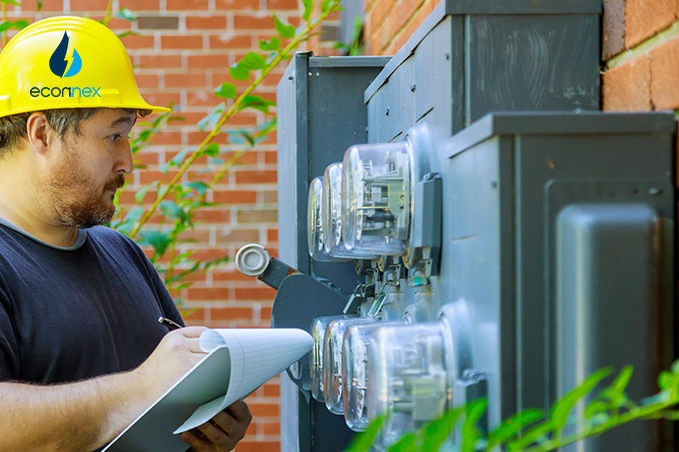Effortlessly manage electricity connection during your move. Get expert tips to help you with your next move stress-free.

Published on 17/03/2024
By William Walton
Econnex Comparison
Moving is considered more stressful than a divorce or starting a new job. So, we’ve put together some information and tips to help make it a little easier for you. We hope you find it helpful. We will also guide on how to manage your Electricity and Gas Connection.
The key to making a move as easy as possible is organisation. Knowing what you need to do, how to do it and when you need to do it by can make all the difference. So, here are some of the main things to consider when moving:
Utilities cover services supplied to your home. This includes electricity, gas, home phone, internet and water. You’ll want to get these things organised well before the moving day. After all, no one wants to spend the first night at their new home in the dark. So, let’s get into it. Connect Energy through Econnex connection services.
Your energy provider is responsible for disconnecting your electricity and gas. Before you move out, give them a call and inform them about your intention to cancel the service. For a smooth transition give them at least one week’s notice.
Schedule the disconnect date a day or two after you move to your new place. Check the fine print of your contract as you may face early termination fee if the terms do not allow you to transfer it to another address. The exact amount you’ll need to pay to terminate a contract will vary between retailers.
Your current supplier will organise a special meter reading so that they can send you the final bill. This is so you won’t be charged for any electricity drawn to the property after the date you move. Be aware, if you are unable to carry your contract over to your new property, as you may be subject to an early termination fee (only if required).
If you’re unable to keep the same retailer, or you’re looking to change plans, Econnex can help you find a competitive energy plan to suit.
Connecting your electricity and gas should be organised a week or so in advance to make sure everything is sorted and working when you move in. Note: There is usually a connection fee, and this will vary between energy distributors/retailers.
Tip: Not all electricity suppliers offer gas services. And if you were to package your electricity and gas together you may be able to get a better deal. So, if you need both, this could be the perfect opportunity to compare energy plans. By comparing energy plans, you’ll be able to see if you could be entitled to a better deal on your electricity and gas.
If you need a same-day electricity connection, click connect now and go through our online journey. Econnex is partnered with 20+ energy retailers, which can help you connect your electricity and gas the same day. Please note generally there is a cutoff time for the same day connection; therefore, please call 1800013000 once you complete your online application. Few retailers might charge a connection fee for an instant utility connection. Please check the connection fee under the plan detail section.
You can arrange a same-day energy connection for NSW, VIC, SA, QLD and ACT. Please read further about same the day urgent electricity connection below:
Organising a same day connection is very simple with Econnex. All we need is the address you are moving to and your personal information to set up the account. Once your online application for new property is submitted, our customer service team will coordinate with your new supplier to make sure your energy is connected asap.
You might be satisfied with the service your current retailer provides. However, if it’s been a while since you took out your current energy plans, there could be newer plans available in the market. And this could mean some great savings on your energy bills.
Tip: When comparing plans, don’t just look at the advertised sign-up offer. Also consider the usage rates, supply charges and terms and conditions. It’s also worth checking any customer reviews. This could give you some insight into the retailer’s standard of customer service. Also, keep an eye on electricity connection fee. Some retailers do not charge any energy connection fee. Ask Econnex team for the complete list of electricity and gas connection fees.
Will I be charged the same electricity and gas prices with my current retailer? Your rate could be subject to change, depending on the location of your new home. The network tariffs available will depend on your postcode, as different areas are charged varying rates. However, you can check this by doing a simple gas and electricity comparison with Econnex.
The energy sector is regulated in different ways around Australia. In the Australian Capital Territory, New South Wales and Victoria the energy sector is deregulated and customers enjoy full retail competition. This means, you are free to decide, switch and compare energy providers.
In South East Queensland and South Australia, the energy prices in some areas are regulated. While, in Western Australia and the Northern Territory regulations are tighter and you’re not able to switch between electricity retailers. Energy rates will also differ in every state.
What do I need to do if you live in a shared house?
Living in a shared house brings its own challenges when moving. So, it can be a good idea to assign one person in charge of utilities and another in charge of removalists etc.
If you have housemates and the power accounts are under your name, you’ll need to let your gas and electricity suppliers know that you have moved. You must provide them with your new address and organise for one of your other housemates to take over the responsibility for the electricity and gas accounts. To do this, both of you might need to call the company together to ensure it has been completed satisfactorily.
To avoid any delays, make sure that you have the answers to the following questions:
If you don’t let your current retailer know that you’re moving out, they will keep charging you for any power used at the property – and this could result in a hefty and unexpected bill down the track.
Tip: If you are the only person moving out, it’s worth calling the energy retailer after you have moved to make sure your name has been withdrawn from the account.
Moving to a new home is the perfect time to re-evaluate whether or not your current electricity retailer is offering you the best deal. Many electricity retailers will allow you to end a contract with no exit fees if you are moving to a new property. So, don’t waste this opportunity to shop around. Econnex’s comparison tool will help you to find which electricity retailer is offering the best deal for your new home.
Like getting your electricity connected, the more notice you can give your supplier the better. This will help everything go smoothly.
In some cases, a technician may need to visit your new home if:
Want to keep the same number for your home phone? Ask your supplier. If your new home is serviced by the same telephone exchange, you will probably be able to keep your existing number.
As with your energy plans, this could be great time to look at switching your phone and internet provider. Of course, if you’re on an existing contract where there are termination charges, you will need to weigh up the potential savings against any fees.
Tip: On move day, make sure your mobile phone is fully charged. And take your charger with you, so you can find it easily on the day.
When moving out, you may need to organise a final meter reading. To do so, just get in touch with the water provider in your area at least a week before your move. While you’re talking to them, also check if you will need to do anything to arrange for connection of the water service at your new place.
If you’re moving to an existing house or unit with water and wastewater services, you’ll probably find you don’t need to do anything to ‘connect’ the water services. It will be ready to use as soon as you arrive.
Not all home and contents policies will cover your belongings during transit. So, take a minute to check with your insurer if you need to organise extra cover. For example, some insurers might only provide cover moves that are handled by a professional removalist.
Also let your insurer know if you are planning on storing any items off-site during the move. Some policies may cover this, but it’s always best to check.
Of course, if you’re an owner-occupier, don’t forget to make sure your new home and its contents are covered before you move in.
No one wants to miss out on any important mail or phone calls, so make sure you let everyone know your new address and phone number.
Key People to Notify
The first step when updating your details is re-directing your mail. This will make sure you don’t miss out on any important documents or notices.
With Australia Post, you’ll be able to redirect your mail for periods of 1, 3, 6 or 12 months. You’ll also have the option to notify selected banks, insurers, energy providers and telcos of your new address. This can help you save time when notifying other companies.
Redirecting mail will take three full working days to process, so it’s best not to leave this until the last minute.
Tip: You’ll need to provide proof of identity (such as your driver’s licence) to change your address.
Throughout Australia, it’s compulsory to update the address on your driver’s license within a set period of time. For example, in New South Wales you’ll need to let the authorities know your new details within 14 days of moving.
If you’re moving interstate, you’ll need to change your driver’s licence. You might have up to 3 months to change your details in this case. But you’ll need to check the conditions for the state you’re moving to.
Here are some links to help you find the details in your area:
Australian Capital Territory New South Wales Northern Territory Queensland South Australia Tasmania Victoria Western Australia
Unless you’re just starting out and have a lot of friends and family who can help you move, using a professional removalist is always a good idea.
Depending on who you choose, professional removalists can offer a full removal service including packing. And considering packing everything from your clothes to the crystal can take a long time, this can be a very worthwhile investment.
If you use a professional removalist, your belongings may also be covered while they’re in transit. However, you’ll need to check your home and contents insurance policy as you may need to take out extra cover.
If you choose to do the moving yourself, you could look into hiring a van or a ute. This could make a big difference when it comes to moving larger items, like the refrigerator, washing machine, dryer and beds. Also, don’t forget to call in any favours from people you’ve helped move in the past.
Tips: Draw a simple floor plan of your new home so the removalists have a point of reference Mark on the plan where you would like large items like beds and white goods to be placed Label the door of each room, e.g. Billy’s bedroom, home office.
First, you’ll need a plan of attack. If possible, set aside one room to do the packing. This will allow you to start getting things sorted without interrupting your day-to-day life too much.
Work out how many packing boxes you’ll need Just as a rough guide, a 3 bedroom family home with 2 adults plus children might need: 13 extra-large boxes, 31 large boxes, 45 medium boxes and 4 wardrobe boxes. You’ll also need to consider how many boxes you will need wall art. As you can see, that’s a lot of boxes. If you’re hiring professional removalists, they will be able to give you an accurate estimate of how many boxes you will need. They also be able to help you calculate other packing supplies you need. Things you’ll need will include packing paper, packing tape, fragile warning tape and bubble wrap.
Sort items Sorting items in piles marked ‘keep’, ‘donate’, ‘sell’ and ‘rubbish’ can help you speed up the packing process. It can also help you reduce the amount you need to move and the cost of moving.
Pack decorative items first Wall art and ornaments are some of the things you can pack well in advance of the move date. So, get a head start and pack these items first. You’ll be surprised how much time his could save in the lead up to moving.
Pack children’s toys last If you have small children, you (and they) will want to pack their toys last. Also make sure you keep a couple of toys aside, that they can keep with them during the move.
Label everything People tend to misplace and forget little stuff, especially if the whole house is a mess. The simplest way to solve this problem is to sort things by type, kind, or according to which room they’re supposed to go in.
Colour coding is probably the easiest way to do this. Simply use some coloured paper from Officeworks or your local newsagent. Then attach the paper to the packing boxes so it folds over the side. This will allow you to see label even when boxes are stacked on top of each other.
An inventory is also a good idea. It might take some extra time to do this, but you’ll be glad you did when you’re trying to find something at your new place.
Sell or donate some stuff A brand-new house is a brand-new start. So, take this opportunity to dispose of appliances and furniture that you don’t need any more.
Whether it’s a used cabinet or old mattress, as long as it’s still useful, put it aside and organise a garage sale. The money from a garage sale could really help with paying the costs of moving, such as removalists, cleaners and reconnecting the utilities. You could also hold a ‘virtual garage sale’ and sell things through eBay, gumtree or Facebook marketplace.
Local charities are also a good way of disposing of items you no longer need. And you’ll feel great that you’ve help someone in need. Some organisations may even pick up donated items from your home, saving you time and money.
Charities in Australia that accept donations include:
If you need some extra storage space during or after the move, consider off-site storage. This can be especially helpful if you have a short amount of time to pack everything before moving. It will give you the option to sort through items you don’t need right away at a later date. And that can make packing a lot less stressful.
Tips:
If you afford it, it’s best to leave the cleaning to the professionals. Especially the final clean once you’ve moved out. They will have all the supplies and equipment to clean carpets and other floors properly. They will also be able to give bathrooms and kitchens a deep clean.
If you do decide to do it yourself, try and clean as you go. Even before you start packing you can go around the house and check for cobwebs. Then as you start packing items, wipe down any empty cupboards and drawers.
Fireplaces and ovens are another couple of things you may be able to clean in advance – especially if you’re moving during the warmer months.
Note for Renters: Usually you won’t be able to receive your bond back until the property has passed the Property Manager’s inspection. So, you’ll need to make sure the property is completely clean before the moving day.
Sort all of the things that need to be packed and set aside anything that needs to be disposed of. Clean areas one at a time. Make sure you mop and vacuum floors, wipe windows and dispose of all waste before the moving day.
Any carpets will usually have to steam cleaned. Carpet stains are hard to avoid, but sadly landlords will often want them removed regardless. The good news is the stains you uncover while packing can often be removed if treated correctly. So, getting a professional cleaner in this instance can be a good idea – even if you’ve done the rest of the cleaning yourself.
Moving home can be a stressful time for your pets, too. So, take the time to make sure some of their favourite things are kept handy during the move. For example, put a few of their favourite toys in a box so you can have easy access to them. Plus, keep their bedding separate from the main packing boxes, so you set it up at your new home as soon as you arrive.
You’ll also need to update your pet’s microchip records and identification tag with your new address.
If you’re moving between towns or interstate, you might also need to organise the transfer of your pet’s records. Just give your pet’s vet a call and they’ll be able to send their records onto the new vet’s practice.
Tip: Don’t forget to keep your fury friend hydrated on the way to your new home. Just put a bottle of water and their water dish in the same box as their toys, so you can take with you on the day.
Searching for a new house can be exciting, but moving houses is not. It is one of the busiest and most stressful jobs of a person’s life. It can be very expensive too, even if you only have your own belongings to move.
Here’s a breakdown of the potential costs:
Removalist Costs Removalists may be the biggest expense when moving. Based on ING’s Cost of Moving Home Report of 2018, of 600 survey participants, 44% hired a removalist to move their stuff and spent an average of $2,009. Those who did the moving themselves spent an average of $782.
If you’re moving interstate, you could pay thousands of dollars to move all of your belongings. For example, it could cost over $3,000 to move interstate. This is in comparison to around $1,200 for moving to a nearby suburb.
So, if you’re on a budget, consider packing and unpacking yourself. Asking for help from family and friends can be a great discount on your expenses too. Only hire a removalist to do the heavy lifting and a removal van to speed up the process. To go with this option, it can cost around $200-$700 depending on the area in which you live.
Although a self-move is cheaper than with a removalist, there are a lot of other costs you need to consider when working out your moving budget.
Cleaning your old property Cleaners charge by hour. Depending on the company you choose, this can cost around $150 to $300 to clean your home.
Here’s a list of 2020 prices quoted by Airtasker:
House cleaning service Price guide
End of lease cleaning $100-$250
Move in cleaning $50-$150
Carpet cleaning $60-$200
Window cleaning $30-$150
Floor cleaning $30-$120
Ceiling cleaning $50-$200
Oven cleaning $30-$150
Rangehood cleaning $30-$100
Fridge cleaning $20-$50
By looking at this list, you’ll be able to work out where it might be worthwhile hiring a professional cleaner. Plus, you’ll be able to see where you might be able to save some money.
Cost of moving utility services There will usually be a fee when disconnecting and connecting utilities. And they will vary depending on where you live and your retailer. For example, connection fees for electricity can vary between $12 and $100. While gas connection fees can be from $12 to around $50. So, it’s definitely worth comparing energy costs when moving.
Connecting utilities to a new build may cost more – especially if extra work is required (such as installing new poles and wires).
Other Potential Costs (Estimated)
As you can see, the costs of moving can really add up. Lowering your utility bills is one area in which you might be able to save.
By comparing energy plans, you’ll be able to find the most competitive rates for your area.
When moving, forget about doing things at the last minute. Try to start organising things at least 4 to 8 weeks before the moving day. An early start helps the movers check if anything needs special attention on the day. It will also help you avoid late nights of packing in the lead up to the big day.
Here’s a rough timeline to help you keep your packing and moving on schedule.
Key points
We hope you found this information helpful.
Want to tick one thing off your moving list now? Find the best energy deals in your area.



